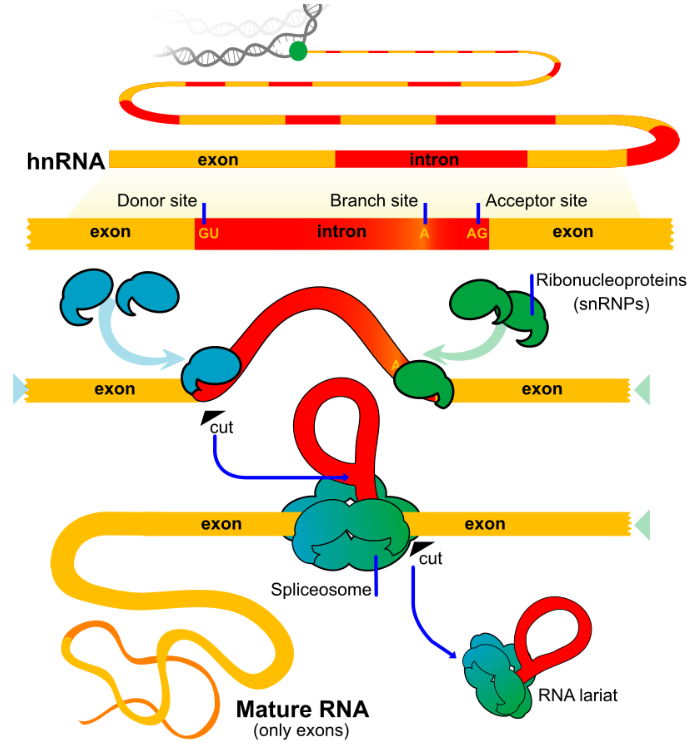
Question: How many adenylate residues are added at the 3' end during the processing of hnRNA in eukaryotes?
A. 50-100
B. 100-150
C. 600-700
D. 200-300
Answer
373.5k+ views
Hint: Heterogeneous nuclear RNA is referred to as hnRNA. It alludes to the substantial pre-mRNAs of different nucleotide sequences produced by RNA Polymerase II and transformed into cytoplasmic mRNAs in the nucleus. RNA Capping, Transcription using RNA Polymerase II.
Complete step-by-step solution:
Longer and confined in the nucleus, the primordial mRNA transcript is also known as pre-mRNA or heterogeneous nuclear RNA (hnRNA). hnRNA has a cap (7-methyl guanosine triphosphate, or 7 mG) at the 5’ end and a tail of poly A (Adenylate residues of 200 to 300) at the 3’ end.

These procedures are referred to as capping and tailing, respectively. The cap is an altered guanosine triphosphate molecule (GTP).
Non-coding introns and coding exons are the two sorts of segments that make up the main mRNAs.
Through a procedure known as RNA splicing, the introns are eliminated, and the exons are then connected in a predetermined order.
The addition of stabilizing and signalling components to the 5′ and 3′ ends of the molecule, as well as the deletion of the introns, are the three most crucial processes in pre-mRNA processing.
The mRNA transcript can occasionally be "edited" after it has been transcribed.
Hence, option D is correct.
200 - 300 adenylate residues are added at 3' end during the processing of hnRNA in eukaryotes.
Note: In an organism, RNA serves a variety of purposes, including coding, decoding, regulating, and the expression of genes. RNA makes up around 5% of the weight of a human cell. DNA only makes up a little portion of a cell—about 1%. Human cells contain RNA in both the cytoplasm and nucleus.
Complete step-by-step solution:
Longer and confined in the nucleus, the primordial mRNA transcript is also known as pre-mRNA or heterogeneous nuclear RNA (hnRNA). hnRNA has a cap (7-methyl guanosine triphosphate, or 7 mG) at the 5’ end and a tail of poly A (Adenylate residues of 200 to 300) at the 3’ end.

These procedures are referred to as capping and tailing, respectively. The cap is an altered guanosine triphosphate molecule (GTP).
Non-coding introns and coding exons are the two sorts of segments that make up the main mRNAs.
Through a procedure known as RNA splicing, the introns are eliminated, and the exons are then connected in a predetermined order.
The addition of stabilizing and signalling components to the 5′ and 3′ ends of the molecule, as well as the deletion of the introns, are the three most crucial processes in pre-mRNA processing.
The mRNA transcript can occasionally be "edited" after it has been transcribed.
Hence, option D is correct.
200 - 300 adenylate residues are added at 3' end during the processing of hnRNA in eukaryotes.
Note: In an organism, RNA serves a variety of purposes, including coding, decoding, regulating, and the expression of genes. RNA makes up around 5% of the weight of a human cell. DNA only makes up a little portion of a cell—about 1%. Human cells contain RNA in both the cytoplasm and nucleus.
Recently Updated Pages
Capping is a process in which A adenylate is added class 12 biology NEET_UG

Explain in brief the separation and isolation of DNA class 12 biology NEET_UG

Number of testicular lobules in testes is A 250 B 500 class 12 biology NEET_UG

The number of solutions in x in 02pi for which sqrt class 12 maths CBSE

Write any two methods of preparation of phenol Give class 12 chemistry CBSE

Differentiate between action potential and resting class 12 biology CBSE

Trending doubts
What is BLO What is the full form of BLO class 8 social science CBSE

Which are the Top 10 Largest Countries of the World?

Fill the blanks with the suitable prepositions 1 The class 9 english CBSE

Why is there a time difference of about 5 hours between class 10 social science CBSE

One Metric ton is equal to kg A 10000 B 1000 C 100 class 11 physics CBSE

What are the major means of transport Explain each class 12 social science CBSE




